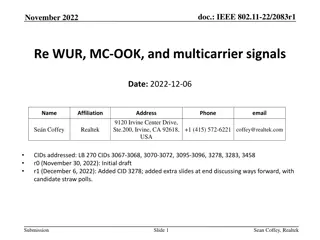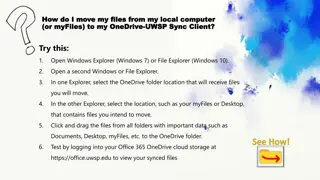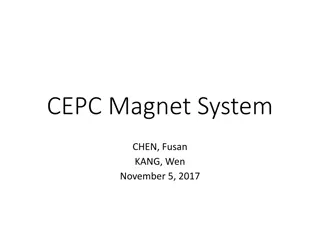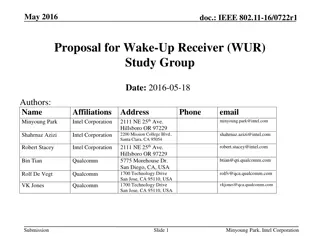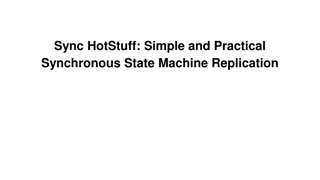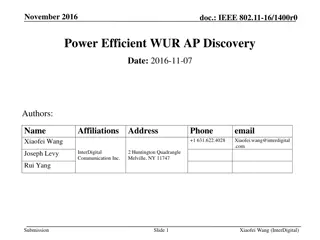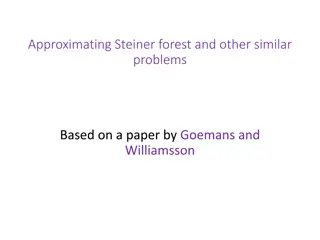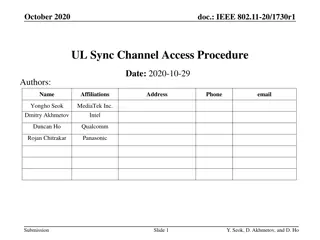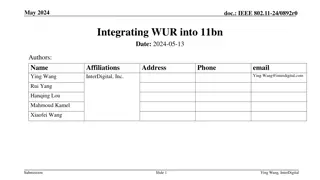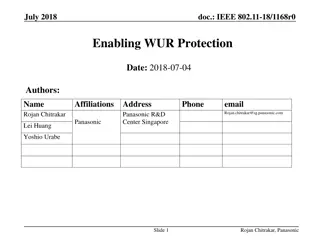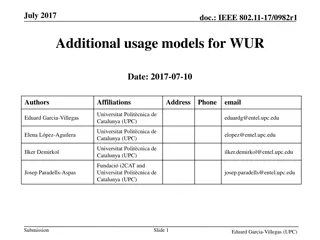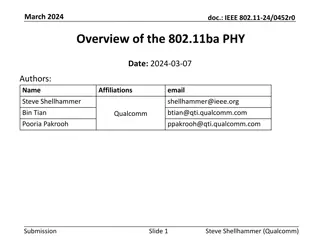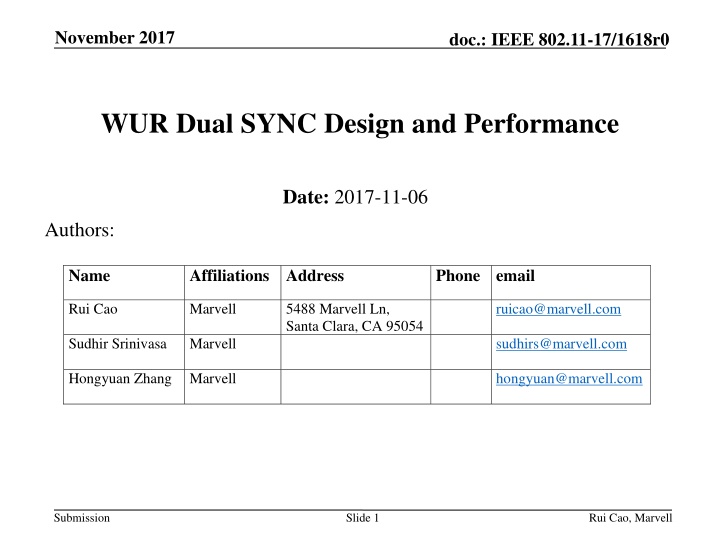
IEEE 802.11-17/1618r0: Dual SYNC Design for WUR in November 2017
Explore the innovative dual SYNC design proposed in IEEE 802.11-17/1618r0 for Wake-Up Radio (WUR) technology in November 2017, aimed at enhancing signaling efficiency and reliability across different data rates. The structured design enables low-complexity receiver implementation for carrier sensing and symbol timing synchronization, offering a significant advancement in wireless communication protocols.
Download Presentation

Please find below an Image/Link to download the presentation.
The content on the website is provided AS IS for your information and personal use only. It may not be sold, licensed, or shared on other websites without obtaining consent from the author. If you encounter any issues during the download, it is possible that the publisher has removed the file from their server.
You are allowed to download the files provided on this website for personal or commercial use, subject to the condition that they are used lawfully. All files are the property of their respective owners.
The content on the website is provided AS IS for your information and personal use only. It may not be sold, licensed, or shared on other websites without obtaining consent from the author.
E N D
Presentation Transcript
November 2017 doc.: IEEE 802.11-17/1618r0 WUR Dual SYNC Design and Performance Date: 2017-11-06 Authors: Name Affiliations Address Phone email Rui Cao Marvell 5488 Marvell Ln, Santa Clara, CA 95054 ruicao@marvell.com Sudhir Srinivasa Marvell sudhirs@marvell.com hongyuan@marvell.com Hongyuan Zhang Marvell Submission Slide 1 Rui Cao, Marvell
November 2017 doc.: IEEE 802.11-17/1618r0 Introduction In IEEE September meeting, only two data rates (62.5kbps and 250kbps) are agreed for WUR [1]. In [2, 3, 4], the design of dual SYNC sequences are proposed, which can facilitate two rate signaling. In [5], dual SYNC sequences of different duration are designed to achieve both reliability and efficiency. In this contribution, we propose a new structured design of dual SYNC sequences with different duration, which facilitates low-complexity receiver design for carrier sensing/symbol timing. Submission Slide 2 Rui Cao, Marvell
November 2017 doc.: IEEE 802.11-17/1618r0 Recap: Dual WUR SYNC BPSK Symbol LSTF LLTF LSIG WUR Data WUR SYNC1 BPSK Symbol LSTF LLTF LSIG WUR Data WUR SYNC2 WUR preamble can have two possible SYNC sequences associated with the two data rates If WUR Data is transmitted with 62.5kbps rate, SYNC1 will be used. If WUR Data is transmitted with 250kbps rate, SYNC2 will be used. Receiver needs to detect SYNC pattern in order to use correct data rate to decode the WUR Data portion. Submission Slide 3 Rui Cao, Marvell
November 2017 doc.: IEEE 802.11-17/1618r0 Long-short Dual SYNC Dual SYNC with one longer and one shorter duration Longer SYNC1 is associated with the lower rate to achieve better reliability. Shorter SYNC2 is associated with the higher rate to achieve better efficiency. For example, WUR Data has 48bits payload, if SYNC2 for high data rate reduces from 128us to 64us, the packet duration reduces by 20%. This reduction can be translated to 20% receiver power consumption reduction and traffic time reduction In [5], we proposed the design of long-short Dual SYNC based on two M-sequences Good autocorrelation and cross-correlations are achieved Two separate correlators are needed at the receiver for CS/synchronization. Some concern was raised for high receiver complexity. Slide 4 Submission Rui Cao, Marvell
November 2017 doc.: IEEE 802.11-17/1618r0 Long-short Dual SYNC Design Criteria Simple receiver processing for carrier sensing and timing synchronization For example, usage of only one correlator Reliable performance lower false alarm rate, miss detection rate, and false sync detection between the two data rates Higher efficiency for 250Kbps without sacrificing complexity and performance Use shorter SYNC duration Submission Slide 5 Rui Cao, Marvell
November 2017 doc.: IEEE 802.11-17/1618r0 Proposed Long-short Dual SYNC Design Dual sequence design method Design one base sequence Z of length N (sequence of 1s and 0s). Z can be designed from an M-sequence of length N-1. Add one extra 1 or 0 similar to [5] to achieve zero DC receiver correlator template and good correlation properties. Construct SYNC1 and SYNC2 based on Z and its complementary 1-Z: SYNC1=[Z Z] Z Z SYNC2=1-Z 1-Z The design can accommodate any base sequence design of Z and the sync ON waveform duration. Submission Slide 6 Rui Cao, Marvell
November 2017 doc.: IEEE 802.11-17/1618r0 Basic Receiver for Long-short SYNC The receiver will correlate with template (2Z-1), and the correlator output will have: two positive peaks if SYNC1 is transmitted, and one negative peak if SYNC2 is transmitted. Carrier sensing Claim packet detection if the absolute correlator output pass certain threshold SYNC type (i.e data rate) can detected by the sign of the output at the point of carrier sensed. Timing Determine the timing by the peak of the correlator output after carrier sensing within certain window For low data rate, both carrier sensing and timing can be enhanced by using combined peak output. Submission Slide 7 Rui Cao, Marvell
November 2017 doc.: IEEE 802.11-17/1618r0 Example of Z Sequence Z of length N= 32 Z = [0 0 0 1 0 1 1 0 1 0 1 0 0 0 1 1 1 0 1 0 1 1 1 1 0 0 1 0 0 1 1 0]; Correlation output based on 2us sync ON waveform duration Total duration 64us for high rate and 128us for low data rate 1 0.8 0.6 Normalized Correlation Ouput 0.4 0.2 0 -0.2 -0.4 -0.6 SYNC1: 62.5kbps SYNC2: 250kbps -0.8 -1 0 100 200 300 400 sample index 500 600 700 800 900 Submission Slide 8 Rui Cao, Marvell
November 2017 doc.: IEEE 802.11-17/1618r0 Simulation Settings WUR Packet WUR Data signal uses center ~4MHz in 20MHz bandwidth Payload: 48 bits, Manchester Coding 2ms noise appended before the WUR packet SNR defined on 20MHz noise CFO = 20ppm, fc = 2.4GHz, No phase noise Receiver Realistic AGC: entire packet is normalized to certain gain target BPSK Symbol 2ms noise WUR Data LLTF LSIG WUR SYNC LSTF Noise portion normalized based on the noise power WUR portion normalized by 20MHz preamble power 5th order 4MHz butterworth filter with 2.5MHz cutoff frequency 8MHz sampling rate with in-phase path Submission Slide 9 Rui Cao, Marvell
November 2017 doc.: IEEE 802.11-17/1618r0 False Alarm/Miss Detection: AWGN WUR DualSync,AWGN, False/Miss Rate @SNR:-5dB WUR DualSync,AWGN, False/Miss Rate @SNR:5dB 0 0 10 10 FalseAlarm-SYNC1 FalseAlarm-SYNC2 MissDet-SYNC1 MissDet-SYNC2 FalseSync-SYNC1 FalseSync-SYNC2 -1 -1 10 10 Error Rate Error Rate -2 -2 10 FalseAlarm-SYNC1 FalseAlarm-SYNC2 MissDet-SYNC1 MissDet-SYNC2 FalseSync-SYNC1 FalseSync-SYNC2 10 -3 -3 10 10 0.1 0.2 0.3 0.4 0.5 0.6 0.7 0.8 0.9 0.1 0.2 0.3 0.4 0.5 0.6 0.7 0.8 0.9 threshold ratio threshold ratio threshold ratio: CS detection threshold/correlation peak (noise-free, AWGN) Miss detection: No CS found False alarm: CS found within 2ms noise portion FalseSync: CS found in SYNC portion but SYNC type is detected in error Submission Slide 10 Rui Cao, Marvell
November 2017 doc.: IEEE 802.11-17/1618r0 Channel: AWGN WUR DualSync, AWGN, 62.5kbps, SyncChip:2us WUR DualSync, AWGN, 250kbps, SyncChip:2us 0 0 10 10 PER: RealTiming PER: IdealTiming FalseAlarm Miss Detection False SyncType PER: RealTiming PER: IdealTiming FalseAlarm Miss Detection False SyncType -1 -1 10 10 PER PER -2 -2 10 10 -3 -3 10 10 -10 -8 -6 -4 -2 0 2 -10 -8 -6 -4 -2 0 2 SNR(dB) SNR(dB) Real timing is close to ideal timing/CS False sync detection is clean Miss detection rate is one order lower from PER Submission Slide 11 Rui Cao, Marvell
November 2017 doc.: IEEE 802.11-17/1618r0 Channel: DNLOS WUR DualSync, DNLos, 62.5kbps, SyncChip:2us WUR DualSync, DNLos, 250kbps, SyncChip:2us 0 0 10 10 PER: RealTiming PER: IdealTiming FalseAlarm Miss Detection False SyncType PER: RealTiming PER: IdealTiming FalseAlarm Miss Detection False SyncType -1 -1 10 10 PER PER -2 -2 10 10 -3 -3 10 10 -10 -5 0 5 10 15 -10 -5 0 5 10 15 SNR(dB) SNR(dB) Real timing is close to ideal timing/CS False sync detection is ~0.1% Submission Slide 12 Rui Cao, Marvell
November 2017 doc.: IEEE 802.11-17/1618r0 Channel: UMi-NLos WUR DualSync, UMi-NLOS, 62.5kbps, SyncChip:2us 0 10 PER: RealTiming PER: IdealTiming FalseAlarm Miss Detection False SyncType -1 10 PER -2 10 -3 10 -10 -5 0 5 10 15 SNR(dB) Real timing is close to ideal timing/CS False sync detection is below error floor, ~0.1% Submission Slide 13 Rui Cao, Marvell
November 2017 doc.: IEEE 802.11-17/1618r0 Summary Long-short dual SYNC design is beneficial for two-rate WUR system with both reliability and efficiency High-rate packet can save ~20% packet duration The proposed long-short SYNC design based on one base sequence and complementary sequence can facilitate simpler receiver design False SYNC type detection rate is much lower than false detection and miss detection rate Submission Slide 14 Rui Cao, Marvell
November 2017 doc.: IEEE 802.11-17/1618r0 Straw Poll 1 Do you agree that 11ba preamble to have the following dual SYNC design? one SYNC with longer duration to signal 62.5kbps data rate, and one SYNC with shorter duration to signal 250kbps data rate. Y: N: A: Submission Slide 15 Rui Cao, Marvell
November 2017 doc.: IEEE 802.11-17/1618r0 Straw Poll 2 Do you agree that 11ba preamble to have the following design of long-short dual SYNC? Design a base sequence Z Longer SYNC1 is two repetition of Z Z Z Shorter SYNC2 is the complementary sequence 1-Z. 1-Z Y: N: A: Submission Slide 16 Rui Cao, Marvell
November 2017 doc.: IEEE 802.11-17/1618r0 Reference [1] IEEE 802.11-17/1345r5, PHY frame format discussions [2] IEEE 802.11-17/0679r2, Preamble Design for WUR WLAN [3] IEEE 802.11-17/0997r0, preamble-options [4] IEEE 802.11-17/0991r0, preamble-design-and- simulations [5] IEEE 802.11-17/1343r0, WUR preamble SYNC design and performance Submission Slide 17 Rui Cao, Marvell




